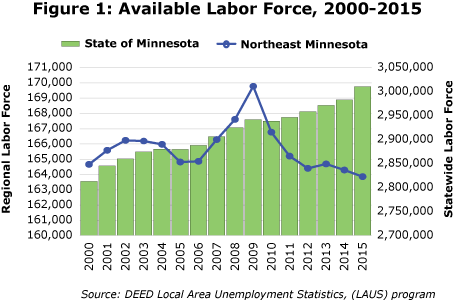
by Erik White
June 2016
The mining downturn has taken a toll in Northeast Minnesota.
Since hitting a peak of 170,000 workers in 2009, Northeast Minnesota has experienced a considerable decline in its labor force, falling to just below 164,000 workers in 2015. It is the only region of the state that has fewer workers now than it had at the turn of the century.
The seven-county Arrowhead region did see an increase in its labor force in response to the 2007 recession, when workers entered the labor market to earn additional income. Even as the region recovered from the recession, people left the workforce due to retirements and job opportunities elsewhere (see Figure 1).

The region's labor force exodus has picked up steam since the end of the recession, leaving the Arrowhead with the biggest decline of the six planning regions statewide (see Table 1).
| Labor Force Trends by Region, 2009-2015 | ||||
|---|---|---|---|---|
| 2009 Labor Force | 2015 Labor Force | Change from 2009-2015 | ||
| Number | Percent | |||
| State of Minnesota | 2,941,976 | 3,010,366 | 68,390 | 2.3% |
| Twin Cities | 1,601,871 | 1,656,951 | 55,080 | 3.4% |
| Central | 374,741 | 384,846 | 10,105 | 2.7% |
| Northwest | 296,167 | 301,619 | 5,452 | 1.8% |
| Southeast | 273,813 | 279,439 | 5,626 | 2.1% |
| Southwest | 225,616 | 223,653 | -1,963 | -0.9% |
| Northeast | 169,773 | 163,864 | -5,909 | -3.5% |
| Source: DEED Local Area Unemployment Statistics (LAUS) program | ||||
While the regional labor force has fallen since the height of the recession, so too has the number of unemployed workers. As of 2015 there were fewer than 9,000 unemployed people in the Arrowhead, nearly 7,000 fewer than in 2009.
Still, the region's 5.3 percent unemployment rate in 2015 was 1.6 percentage points higher than the state overall. The mining downturn and thousands of layoffs in the mines and supporting industries has had a great effect on the region's unemployment rate, with many laid off workers hoping to get back to work in these high-paying jobs.
Northeast Minnesota's 60.8 percent labor force participation rate is considerably lower than the state overall – nearly 10 percent lower and easily the lowest of the six planning regions.
The difference is partly due to the region's older workforce, but even when controlling for age, the region has lower participation rates for all age cohorts. For workers ages 25 to 54 – the prime working years – Northeast Minnesota's participation rate lags the state by about 4.5 percent. These workers account for about 60 percent of the total labor force in the region (see Table 2).
| Northeast Minnesota Employment Characteristics, 2014 | |||||
|---|---|---|---|---|---|
| Northeast Minnesota | Minnesota | ||||
| In Labor Force | Labor Force Participation Rate | Unemployment Rate | Labor Force Participation Rate | Unemployment Rate | |
| Total Labor Force | 163,614 | 60.8% | 7.9% | 70.1% | 6.5% |
| Employment Characteristics by Age Group | |||||
| 16 to 19 years | 8,796 | 49.0% | 19.1% | 51.1% | 18.7% |
| 20 to 24 years | 18,902 | 78.8% | 11.4% | 81.8% | 10.2% |
| 25 to 44 years | 59,854 | 83.7% | 8.0% | 88.1% | 5.8% |
| 45 to 54 years | 38,617 | 82.8% | 6.4% | 87.3% | 5.0% |
| 55 to 64 years | 30,473 | 60.6% | 4.5% | 71.8% | 4.9% |
| 65 to 74 years | 5,825 | 18.6% | 4.3% | 26.6% | 4.1% |
| 75 years and over | 1,068 | 3.9% | 5.0% | 5.9% | 3.5% |
| Employment Characteristics by Race and Hispanic Origin | |||||
| White alone | 154,115 | 61.0% | 7.3% | 70.2% | 5.6% |
| Black or African American | 1,375 | 48.4% | 23.2% | 68.0% | 16.4% |
| American Indian and Alaska Native | 3,747 | 59.4% | 15.2% | 59.4% | 17.4% |
| Asian or Other Pacific Islanders | 1,374 | 65.8% | 4.9% | 70.6% | 7.2% |
| Some Other Race | 403 | 65.6% | 13.9% | 76.2% | 11.0% |
| Two or More Races | 2,515 | 55.7% | 20.4% | 69.5% | 13.2% |
| Hispanic or Latino | 1,744 | 61.9% | 5.7% | 75.0% | 10.1% |
| Employment Characteristics by Disability | |||||
| With Any Disability | 9,612 | 42.2% | 16.8% | 51.0% | 14.0% |
| Source: 2010-2014 American Community Survey, 5-Year Estimates | |||||
Despite making up a larger percentage of the region's total population, people over 55 have a substantially lower participation rate in Northeast Minnesota than statewide.
One factor could be that retiring baby boomers are choosing to move full time to the region's many vacation homes, but that does not explain all of the difference. For example, people ages 55 to 64 – not quite at traditional retirement age – had only a 60.6 percent participation rate in the region, more than 11 percentage points below the state.
Drawing some of these workers into the labor force could have a huge impact. If participation rates for people over 55 rose to match the statewide rate, the region would gain an additional 8,600 workers. Similarly, increasing labor force participation rates for people 25 to 54 to match the state rate would result in 5,200 more workers. Engaging these potential workers becomes increasingly critical as the region's labor market tightens and businesses seek to expand or replace retiring workers.
While 94 percent of the labor force in Northeast Minnesota is white, there is a growing minority population in the region that is facing considerable employment disparities. Less than half of the region's black residents of working age are in the labor force, and their unemployment rate is three times higher than that of whites.
American Indians are the largest minority group in Northeast Minnesota's labor force, and while their labor force participation rate is similar to that of whites, their unemployment rate is over twice as high at 15.2 percent, providing more evidence of racial economic disparities in the region (see Table 2).
Lowering unemployment rates for minorities in line with the unemployment rates of whites would result in an increase of nearly 850 more jobs filled in the region. As the region's labor force decreases and the labor market tightens, a major priority for the area ought to be eliminating current racial economic disparities.
Assuming there are no changes to current labor force participation rates by age group, population projections from the State Demographic Center show that the Northeast labor force could decrease by nearly 10,000 people by 2025. Increases in younger and older workers get overwhelmed by further declines in the middle-age groups (see Table 3).
| Northeast Minnesota Labor Force Projections, 2015-2025 | ||||
|---|---|---|---|---|
| 2015 Labor Force | 2025 Labor Force Projection | 2015-2025 Change | ||
| Numeric | Percent | |||
| 16 to 19 years | 10,266 | 9,779 | -487 | -4.7% |
| 20 to 24 years | 17,548 | 18,960 | +1,412 | +8.0% |
| 25 to 44 years | 58,241 | 57,932 | -310 | -0.5% |
| 45 to 54 years | 35,967 | 28,387 | -7,579 | -21.1% |
| 55 to 64 years | 31,568 | 25,646 | -5,922 | -18.8% |
| 65 to 74 years | 6,856 | 9,417 | +2,561 | +37.4% |
| 75 years and over | 1,237 | 1,796 | +559 | +45.2% |
| Total Labor Force | 161,683 | 151,917 | -9,765 | -6.0% |
| Source: Minnesota State Demographic Center | ||||
The 45- to 64-year-old cohort is expected to lose 13,500 workers in the next 10 years, draining a lot of expertise, knowledge and skills from the regional economy.
The labor force decrease means the current tight labor market will continue, and employers should expect increased competition for available workers. This might lead to increased wages, additional benefits and improvements in workplace culture.
These shifts were already under way over the past decade, with the number of jobs held by workers 55 and over rising by more than 14,000 from 2005 to 2015. Interestingly, there was also a substantial increase in the number of job holders from 25 to 34 years of age, suggesting that industries in the region have already begun replacing their aging workforces by seeking out and hiring younger people (see Table 4).
| Northeast Minnesota Change in Jobs Held by Age Cohort, Second Quarter 2005 – Second Quarter 2015 | |||||
|---|---|---|---|---|---|
| Under 25 years | 25-34 years | 35-44 years | 45-54 years | 55-64 years | Over 65 years |
| -698 | +5,844 | -276 | -4,467 | +10,977 | +3,170 |
| -3.3% | +23.3% | -0.9% | -12.1% | +60.8% | +88.4% |
| Source: DEED Quarterly Workforce Indicators (QWI) program | |||||
Replacing these workers and preparing the next generation of workers for economic success will be a major priority for Northeast Minnesota. The issue will affect individual industries differently, depending on their current concentration of older workers. Nearly one-quarter of all jobs in Northeast Minnesota are held by those 55 years and over (see Table 5).
| Northeast Minnesota Workforce by Industry, Second Quarter 2015 | |||
|---|---|---|---|
| Total Workers | Jobs Held by Workers 55 Years and Over | ||
| Number | Number | Percent | |
| Total, All Industries | 149,270 | 35,779 | 24.0% |
| Health Care and Social Assistance | 34,609 | 8,315 | 24.0% |
| Retail Trade | 16,560 | 3,832 | 23.1% |
| Educational Services | 14,144 | 4,770 | 33.8% |
| Accommodation and Food Services | 13,717 | 1,602 | 11.7% |
| Public Administration | 9,638 | 2,746 | 28.5% |
| Manufacturing | 9,148 | 2,315 | 25.3% |
| Transportation and Warehousing | 7,615 | 1,821 | 23.9% |
| Construction | 6,935 | 1,253 | 18.1% |
| Mining | 5,228 | 1,417 | 27.1% |
| Professional and Technical Services | 5,268 | 1,214 | 23.0% |
| Other Services | 4,444 | 1,186 | 26.7% |
| Finance and Insurance | 5,093 | 1,319 | 25.9% |
| Admin. Support and Waste Mgmt. | 4,172 | 917 | 22.0% |
| Arts, Entertainment and Recreation | 3,640 | 879 | 24.1% |
| Wholesale Trade | 3,193 | 812 | 25.4% |
| Utilities | 2,049 | 512 | 25.0% |
| Information | 1,390 | 344 | 24.7% |
| Real Estate, Rental and Leasing | 1,108 | 343 | 31.0% |
| Management of Companies | 840 | 144 | 17.1% |
| Agriculture | 516 | 121 | 23.4% |
| Source: DEED Quarterly Workforce Indicators (QWI) program | |||
Educational services has the highest concentration, with over one-third of all jobs held by workers at or within 10 years of the traditional retirement age. Meanwhile, health care and social assistance has the most employees who are 55 and older, with 8,315 workers. These industries will face the biggest challenges in replacing their workforces in the next decade.
They won't be alone, however, as the entire region's economy deals with the shrinking labor force and replacing older workers. With challenges come opportunity, and the Arrowhead should be home to plenty. Eliminating racial economic disparities and engaging those not currently in the labor force are paths that can be taken immediately to ensure future economic success in Northeast Minnesota.